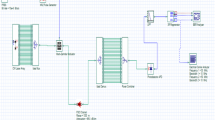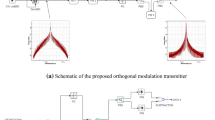Abstract
Free-space optics (FSO) offers a lot of network-specific merits over radio-frequency (RF) links because of its license-free bandwidth, ease of installation, and cost for short-distance communication. This investigation offers a framework on the performance of hybrid FSO/RF, which suffers from various atmospheric conditions. To overcome the drawbacks faced by the FSO link, a reliable RF link is used as a secondary link. As observed by comprehensive literature survey, using some technologies like employing relay nodes, the error rate or coverage area can be improved. Further, modulation techniques like binary phase shift key (BPSK) and multiple pulse position modulation (M-PPM) can be used as signaling techniques for improving the performance of communication link. These approaches provide better results in terms of quality of service (QoS), bit error rate (BER), eye opening, jitter, etc., in different weather conditions.





Similar content being viewed by others
Change history
13 September 2022
A Correction to this paper has been published: https://doi.org/10.1007/s12596-022-00936-7
References
B. Bag, A. Das, I.S. Ansari, A. Prokes, C. Bose, A. Chandra, Performance analysis of hybrid FSO systems using FSO/RF-FSO link adaptation. IEEE Pho. Jour. 10(3), 1–17 (2018)
L. Grigoriu, Availability of a hybrid FSO/RF link while using the link’s diversity for packet scheduling. Wirel. Commun. Mob. Comput. (2018). https://doi.org/10.1155/2018/7320989
M.A. Amirabadi, V.T. Vakili, Performance analysis of a novel hybrid FSO/RF communication system. IET Opt. 14, 66–74 (2020)
H. Khalid, S.S. Muhammad, H.E. Nistazakis, G.S. Tombras, Performance analysis of hard-switching based hybrid FSO/RF system over turbulence channels. Comm. 7(2), 1–10 (2019)
M.A. Amirabadi, A novel hybrid FSO/RF communication system with receive diversity. Opt. 184, 293–298 (2019)
A. Akbulut, M. Efe, A. M. Ceylan, F. Ari, Z. Telatar, H. G. Ilk, S. Tugac, An experimental hybrid FSO/RF communication system, Proceedings (393) Communication System and Network Babalmadena, (Spain, 2003)
V.K. Tonk, P.K. Yadav, On the performance of hybrid RF/FSO relay algorithms for 5G wireless communication systems. Int. J. Fut. Gen. Comm. Net. 10(10), 41–50 (2017)
A. Basahel, W. Al-Khateeb, Carrier class availability prediction for hybrid FSO/RF system in heavy rainfall regions based on ITU-R models. Int. J. Comp. Comm. Eng. 3(6), 404–407 (2014)
A.M. Salhab, A new scenario of triple-hop mixed RF/FSO/RF relay network with generalized order user scheduling and power allocation. EURASIP J. Wire. Comm. Net. 260, 1–20 (2016)
A. Eslami, S. Vangala, H. Pishro-Nik, Hybrid channel codes for efficient FSO/RF communication systems. IEEE Tran. on Comm. 58(10), 2926–2938 (2010)
H. Moradi, M. Falahpour, H. H. Reafi, P. G. LoPresti, M. Atiquzzaman, Availability modelling of FSO/RF mesh networks through turbulence-induced fading channels In 2010 INFOCOM IEEE Conference on Computer Communications Workshops, (San Diego, USA, 2010)
F. Nadeem, V. Kvicera, M.S. Awan, E. Leitgeb, S.S. Muhammad, G. Kandus, Weather effects on hybrid FSO/RF communication link. IEEE J. Sel. Areas Comm. 27(9), 1687–1697 (2009)
A. Akbulut, M. Efe, A. M. Ceylan, F. Ari, Z. Telatar, H. G. Ilk, S. Tugac, An experimental hybrid FSO/RF communication system. Proceedings Communication System and Network, (Spain, 2003)
W. Kogler, P. Schrotter, U. Birnbacher, E. Leitgeb, O. Koudelka, Hybrid wireless networks high availability with combined optical/microwave links (Konferenztcmc, Austria, 2003)
E. Leitgeb , M. Gebhart, High availability of hybrid wireless networks (In Proceeding of SPIE, 2004)
S. D. Milner, C. C. Davis, Hybrid free space optical/RF networks for tactical operations (In MILCOM, Mont. USA, 2004)
T. H. Ho, S. Trisno, A. Desai, J. Llorca, S. D. Milner, C. C. Davis, Performance and analysis of reconfigurable hybrid FSO/RF wireless networks Proceedings SPIE, Laser and application in science and engineering, (San Jose, California, US, 2005)
A. Kashyap, M. Shayman, Routing and traffic engineering in hybrid RF/FSO networks Proceeding IEEE International Conference on Communications, (Seoul Korea, 2005)
H. Wu, B. Hamzeh, M. Kavehrad, Availability of airborne hybrid FSO/RF links Proceeding SPIE, Defense and Security, (Orlando, Florida, US, 2005)
M.A. Khalighi, M. Uysal, Survey on free space optical communication: A communication theory perspective. IEEE Comm. Sur. Tutor. 16(4), 2231–2258 (2014)
A. Kumar, A. Dhiman, D. Kumar, N. Kumar, Free space optical communication system under different weather conditions. IOSR J. Eng. 3(12), 52–58 (2013)
I.K. Son, S. Mao, A survey of free space optical networks. Dig. Comm. Net. 2, 67–77 (2017)
H.G. Sandalidis, T.A. Tsiftsis, BER performance of FSO links over strong atmospheric turbulence channels with pointing errors. IEEE Comm. Let. 12(1), 44–46 (2008)
A. Malik, P. Singh, Free space optics: Current applications and future challenges. Int. J. Opt. (2015). https://doi.org/10.1155/2015/945483
S. Nagpal, A. Gupta, An analytical approach for performance enhancement of FSO communication system using array of receivers in adverse weather conditions. J. Opt. Comm. 38(3), 287–291 (2017)
H. Kaushal, G. Kaddoum, Optical communication in space: Challenges and mitigation techniques. IEEE Comm. Sur. Tutor. 19(1), 57–96 (2016)
S. Bloom, E. Korevaar, J. Schuster, H. Willebrand, Understanding the performance of free-space optics. J. Opt. Net. 2(6), 178–200 (2003)
K. Rammprasath, P. Shanthi, Analyzing the cloud attenuation on the performance of free space optical communication. International Conference on Communication and Signal Processing IEEE, (Melmaruvathur, India, 2013)
J. Singh, N. Kumar, Performance analysis of different modulation format on free space optical communication system. Optik 124(20), 4651–4654 (2013)
A. K. Rahman, M.S Anuar, S. A. Aljunid , M. N. Junita, Study of rain attenuation consequence in free space optic transmission (6th National Conference on Telecommunication Technologies and 2008 2nd Malaysia Conference on Photonics August 2008).
G. Shaulov, J. Patel, B. Whitlock, P. Mena, R. Scarmozzino, Simulation-assisted design of free space optical transmission systems, IEEE Military Communications Conference, (Atlantic City, NJ, 2005)
H.-A. Willebrand, S.-G. Baksheesh, Fiber optics without fiber. IEEE Spec. 38(8), 40–45 (2001)
J. Llorca, A. Desai, E. Baskaran, S. Milner, C. Davis, optimizing performance of hybrid FSO/RF networks in realistic dynamic scenarios Proceeding SPIE, optics and photonics, (San Diego, California, US, 2005)
J. Derenick, C. Thorne, J. Spletzer, On the deployment of a hybrid free-space optic/radio frequency (FSO/RF) mobile ad-hoc network In IEEE/RSJ International Conference on Intelligent Robots and Systems Bethlehem, (PA, USA, 2005)
A Sana H Erkan SR Ahmed MA Ali 2006 Design and performance of hybrid FSO/RF architecture for next generation broadband access networks Proceeding of SPIE optics east Massachusetts, US, Boston, 2006
Z. Jia, F. Ao, Q. Zhu, BER performance of the hybrid FSO/RF attenuation system In 7th International Symposium on Antennas, Propagation & EM Theory IEEE, Guilin, China, 2006
H. Wu, M. Kavehrad, Availability evaluation of ground-to-air hybrid FSO/RF links. Int. J. Wire. Info. Net. 14(1), 33–45 (2007)
O. Awwad, A. Al-Fuqaha, B. Khan, G.B. Brahim, Topology Control Schema for Better QoS in Hybrid RF/FSO Mesh Networks. IEEE Tran. Commun. 60(5), 1398–1406 (2012)
E. Erdogan, I. Altunbas, N. Kabaoglu, H. Yanikomeroglu, A cognitive radio enabled RF/FSO communication model for aerial relay networks: Possible configurations and opportunities. IEEE Open J. of Vehi. Tech. 2, 45–53 (2021)
R. Benjamin, D. Ginthör, J. P. Labrador, J. Ramirez, C. Schmidt, C. Fuchs, Demonstration of an FSO/RF hybrid communication system on aeronautical and space applications Proceeding of SPIE 11506, Laser Communication and Propagation through the Atmosphere and Oceans IX, international society for optics and photonics, 2020
L. Kong, W. Xu, L. Hanzo, H. Zhang, C. Zhao, Performance of a free-space-optical relay-assisted hybrid RF/FSO system in generalized m-distributed channels. IEEE Phot. J. 7(5), 7903319–7903338 (2015)
B. Makki, T. Svensson, K. Buisman, J. Perez, M.S. Alouini, Wireless energy and information transmission in FSO and RF-FSO links. IEEE Wire. Comm. Let. 7(1), 90–93 (2017)
P. Krishnan, Performance analysis of hybrid RF/FSO system using BPSK-SIM and DPSK-SIM over gamma- gamma turbulence channel with pointing errors for smart city applications. IEEE Acc. 6, 75025–75032 (2018)
S. Sharma, A.S. Madhukumarand, R. Swaminathan, Effect of pointing errors on the performance of hybrid FSO/RF networks. IEEE Acc. 7, 131418–131434 (2019)
I. S. Ansari, Mohamed M. Abdallah, M. S. Alouini, A. Khalid, A Performance Study of Two Hop Transmission in Mixed Underlay RF and FSO Fading Channels Wireless communication and networking conference IEEE, (Istanbul, Turkey, 2014)
H. Saidi, N. Hamdi, End-to-end performance of DF multihop hybrid RF/FSO system using MPPM coding and MIMO technique under dependent GG turbulence channels. Indo. J. Elec. Eng. Comp. Sci. 19(2), 811–818 (2020)
L. Yang, J. Yuan, X. Liu, M.O. Hasna, On the performance of LAP-based multiple-hop RF/FSO systems. IEEE Tran. Aer. Electron. Syst. 55(1), 499–505 (2018)
A. Upadhya, V.K. Dwivedi, G.K. Karagiannidis, On the effect of interference and misalignment error in mixed RF/FSO systems over generalized fading channels. IEEE Tran. Comm. 68(6), 3681–3695 (2020)
A. I. Shafique, M. S. Alouini, F. Yilmaz, On the Performance of Hybrid RF and RF/FSO Fixed Gain Dual-Hop Transmission Systems In Saudi international electronics, communication and photonics conference IEEE 2013
A.K.M.S.J. Choyon, R. Chowdhury, S.M.R. Chowdhury, Optimum link distance and BER performance investigation for BPSK RF sub-carrier coherent FSO communication system under strong turbulence. Int. J. Sci. Tech. Res. 9, 282–287 (2020)
M. Ali, R. Mesleh, M. Abaza, New challenges in wireless and free space optical communications. Opt. Laser Eng. 89, 95–108 (2016)
R. Swaminathan, S. Sharma, N. Vishwakarma, A.S. Madhukumar, HAPS-based relaying for integrated space–air–ground networks with hybrid FSO/RF communication: A performance analysis. IEEE Tran. Aer. Elec. Sys. 57(3), 1581–1599 (2021)
N. Vishwakarma, R. Swaminathan, Performance analysis of hybrid FSO/RF communication over generalized fading models. Optics Comm. 487, 126796 (2021)
N.A. Mohammed, A.S. El-Wakeel, M.H. Aly, Pointing error in FSO link under different weather conditions. Fog 15(33.961), 84–904 (2012)
Author information
Authors and Affiliations
Corresponding author
Additional information
Publisher's Note
Springer Nature remains neutral with regard to jurisdictional claims in published maps and institutional affiliations.
Rights and permissions
Springer Nature or its licensor holds exclusive rights to this article under a publishing agreement with the author(s) or other rightsholder(s); author self-archiving of the accepted manuscript version of this article is solely governed by the terms of such publishing agreement and applicable law.
About this article
Cite this article
Ghatwal, S., Saini, H. Investigations on challenges faced by hybrid FSO/RF high-speed networks. J Opt 52, 924–934 (2023). https://doi.org/10.1007/s12596-022-00898-w
Received:
Accepted:
Published:
Issue Date:
DOI: https://doi.org/10.1007/s12596-022-00898-w




